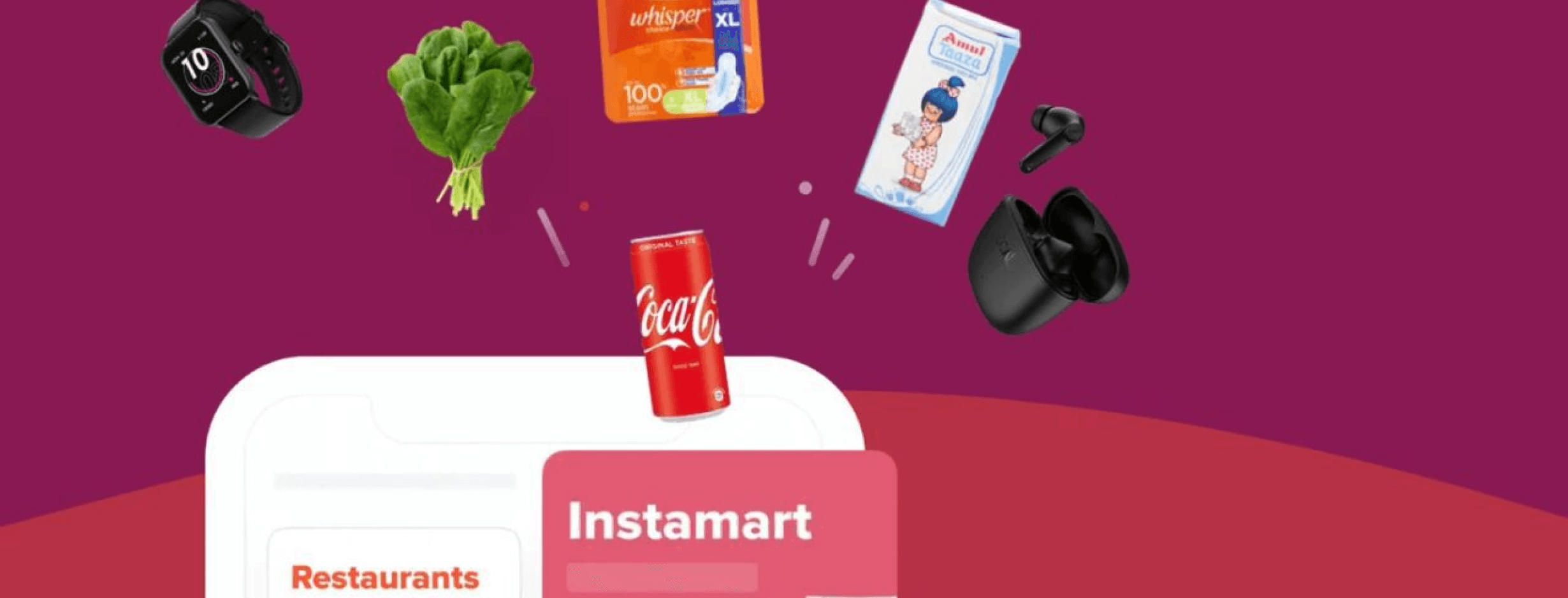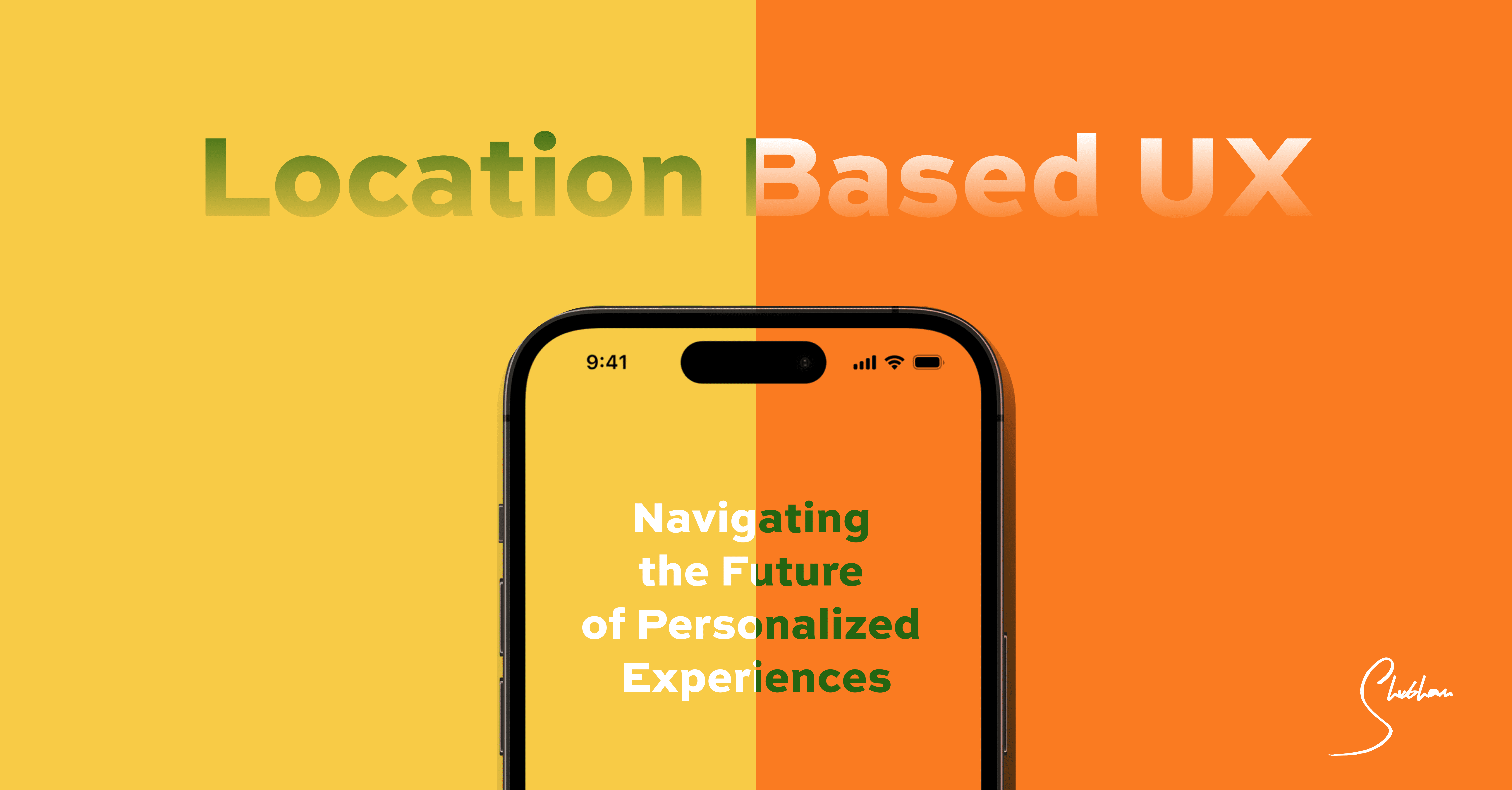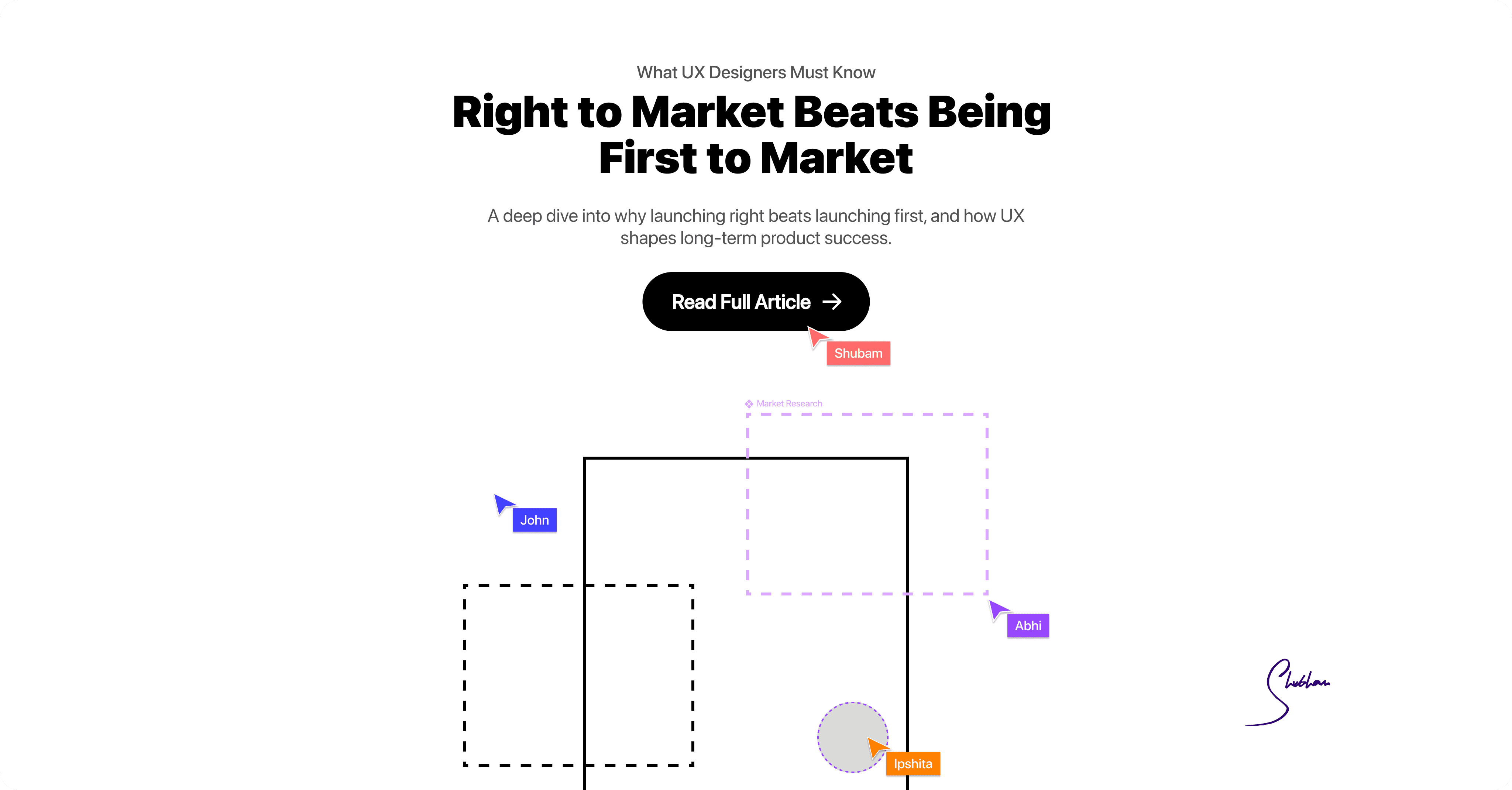The next big thing is the one that makes the last big thing usable.
— Blake Ross, Co-creator of Mozilla Firefox
How Location Based UX is Revolutionizing Digital Experiences and Driving Economic Growth
In an increasingly interconnected world, the fusion of the digital and physical realms is creating unprecedented opportunities for innovation. At the forefront of this convergence lies Location-Based User Experience (UX), an approach that leverages the power of geographical data to craft digital interactions that are not only relevant but also deeply personalized. This innovative concept, often abbreviated as LBUX, centers on the idea that a user’s physical location can significantly influence their needs and preferences in the digital space. By utilizing location data, such as GPS coordinates or proximity to beacons, LBUX enables the delivery of tailored content, services, or information to users precisely when and where they need it most. It moves beyond simply knowing a user’s whereabouts to understanding the context of their location, such as the specific store they might be near in a shopping mall, the time of day, or even their past preferences. The key components of LBUX include the acquisition and analysis of user location data, the understanding of the surrounding context, the personalization of the digital experience, and the provision of real-time updates as the user moves. This strategy aims to significantly improve user satisfaction and engagement by offering experiences that are not only convenient but also anticipate their needs based on their current situation. The evolution of LBUX reflects a broader trend where digital interactions are becoming more intuitive and helpful by seamlessly integrating with the user’s physical environment. The increasing sophistication in how location data is gathered, moving beyond traditional GPS to encompass Wi-Fi triangulation, cell tower data, and even indoor positioning systems, allows for a more nuanced and precise level of personalization than ever before. This blending of the digital and physical worlds is rapidly shaping how individuals interact with technology across a multitude of applications, from navigating a new city to discovering local events and connecting with friends nearby. Businesses are increasingly recognizing the immense potential of LBUX to deliver highly personalized and contextually relevant experiences, leading to enhanced user engagement and ultimately, greater satisfaction.
The Economic Footprint: Location-Based Services as a Catalyst for Growth
The integration of location-based technologies is not just enhancing user experiences; it is also leaving a substantial and rapidly expanding footprint on the global economy. The market for Location-based Services (LBS) has grown into a multi-billion dollar industry, with projections indicating continued strong growth in the years to come. According to one report, the global LBS market was valued at US$214.4 billion in 2024 and is anticipated to reach US$738.6 billion by 2030, demonstrating a Compound Annual Growth Rate (CAGR) of 22.9%. Another analysis estimates a slightly different trajectory, projecting the market to grow from USD 30.49 billion in 2024 to USD 315.78 billion by 2037, with a CAGR of around 19.7%. A third source places the 2024 market value at USD 51.3 billion, forecasting a CAGR of 21.6% to reach USD 346.3 billion by 2034.
These figures, while varying slightly due to different methodologies and scopes, consistently point towards a significant and rapidly growing global market for LBS, underscoring its profound economic impact across a wide array of industries. This growth is fueled by several converging factors, including the increasing proliferation of smartphones and other connected devices, advancements in mobile internet technologies, and the growing adoption of the Internet of Things (IoT). Furthermore, the enhanced accuracy of GPS technology and the development of sophisticated mapping and geospatial analytics tools have propelled the market forward. A key driver is the increasing consumer demand for personalized experiences and real-time information, leading to greater acceptance and reliance on LBS applications.
The applications of LBS are diverse and span numerous sectors. In the realm of smart cities, LBS is being deployed to manage traffic flow, optimize public transportation systems, and ensure the safety of citizens during emergencies. The retail sector is witnessing significant growth through hyperlocal marketing strategies enabled by LBS, allowing businesses to send personalized promotions and advertisements to customers based on their current or past locations, effectively driving foot traffic to physical stores and increasing sales. The transportation and logistics industries are leveraging LBS for fleet management, route optimization, and real-time tracking of shipments, resulting in enhanced operational efficiency and reduced costs. In healthcare, LBS aids in tracking the location of critical medical equipment, optimizing patient flow within hospitals, and providing location-based health alerts. The tourism industry is also benefiting significantly, with LBS enabling personalized recommendations for tourists, augmented reality experiences at historical sites, and location-based tours, enriching their overall travel experiences. Moreover, the location-based advertising market is experiencing substantial growth, with projections reaching into the hundreds of billions of dollars by the end of the decade.
The economic value generated by LBS stems from its ability to drive efficiency, enhance personalization, and facilitate the emergence of new business models. Targeted marketing, enabled by LBS, leads to improved customer experiences through highly relevant and context-aware interactions. Features like geofencing allow businesses to send personalized notifications and offers to users when they enter predefined geographic areas. Location-based content personalization ensures that users receive information tailored to their specific location, making apps and websites more useful and engaging. In logistics, real-time tracking powered by LBS significantly enhances operational efficiency, reduces fuel consumption, minimizes the risk of delays, and ultimately improves customer satisfaction. Location data provides businesses with valuable insights into consumer behavior, enabling them to optimize resource allocation and make more informed strategic decisions. Furthermore, LBS is a key enabler for innovative business models, such as the rapid growth of quick-commerce platforms that prioritize speed and convenience in delivering everyday essentials.
Global Location-Based Services Market: Key Forecasts
Source | Market Size (USD Billion) in 2024 | Projected Market Size (USD Billion) | Year of Projection | CAGR (%) |
GlobeNewswire | 214.4 | 738.6 | 2030 | 22.9 |
Research Nester | 30.49 | 315.78 | 2037 | 19.7 |
GM Insights | 51.3 | 346.3 | 2034 | 21.6 |
This table summarizes the substantial projected growth of the global location-based services market from various sources, highlighting the significant economic opportunities and transformations driven by these technologies.
Case Study: Blinkit - Delivering More Than Just Groceries, Delivering an Experience

Blinkit, formerly known as Grofers, has emerged as a prominent player in the rapidly evolving quick-commerce landscape in India. Founded in 2013 and now operating as a subsidiary of Zomato, Blinkit offers an online platform accessible through a mobile app for users to order a wide array of groceries and essential items. The company has distinguished itself by promising and often achieving delivery within an impressive 10-minute timeframe. Operating in over 30 cities across India, Blinkit relies on a strategically placed network of dark stores to facilitate these ultra-fast deliveries. The product catalog includes a diverse range of everyday necessities, from fresh fruits and vegetables to bakery goods, personal care products, and household essentials. Blinkit’s overarching mission is to create instant commerce indistinguishable from magic, aiming to provide unparalleled convenience and speed for its customers’ daily needs. The company employs a hybrid business model that involves partnerships with local grocery stores while also managing its own inventory within its network of dark stores. Revenue generation for Blinkit comes from various streams, including commissions charged to partner stores, delivery fees paid by customers, subscription fees for its premium service (Blinkit Prime), and revenue from advertising on its platform. The core of Blinkit’s value proposition lies in its commitment to speed and convenience, directly catering to the fast-paced lifestyles of urban consumers. The strategic decision to pivot towards a quick-commerce model and the subsequent rebranding to Blinkit clearly emphasize this central focus. The combination of partnering with local stores and operating its own dark stores suggests a deliberate strategy to balance a wide operational reach with a high degree of control over the end-to-end delivery experience, crucial for maintaining its promise of rapid delivery.
Location-based technologies are deeply embedded within Blinkit’s operational framework, playing a pivotal role in enhancing the overall user experience. The Blinkit app likely utilizes GPS to accurately detect the user’s current location, streamlining the process of store discovery and automatically populating the delivery address. This location data is absolutely critical to Blinkit’s ambitious 10-minute delivery promise, enabling the platform to efficiently connect users with the nearest operational dark store capable of fulfilling their orders. Blinkit employs sophisticated route planning systems that optimize delivery routes in real-time, taking into account various factors such as the service level agreements (SLAs) for delivery, the weight of the order, and the total distance to be covered. These systems leverage geocoders to ensure accurate drop-off locations, contributing to faster and more efficient deliveries. Furthermore, the Blinkit app provides users with real-time tracking of their delivery executive’s location on a map, along with a dynamic estimated time of delivery (ETD). This ETD is calculated based on the delivery executive’s current location, the sequence of other orders in their delivery queue, and real-time traffic conditions, providing users with transparency and managing expectations. On the backend, Blinkit utilizes geospatial data extensively for gaining operational insights, performing detailed analytics, and effectively managing its service boundaries. These boundaries, often represented as polygons on a map, are strategically created by the operations team to divide a city into manageable zones, helping to optimize the supply chain and the network of stores that power their delivery service. Recognizing the strategic importance of this location data, Blinkit has even developed internal Geographic Information System (GIS) tools, such as Sauron, which is built on top of the open-source geospatial visualization tool Kepler.gl. Sauron allows Blinkit’s teams to manage and edit these service boundaries with granular role-based access control, ensuring that the right teams have the necessary permissions to modify and optimize their operational areas. This deep integration of location intelligence across both customer-facing features and internal operational tools is fundamental to Blinkit’s ability to consistently offer ultra-fast delivery and a seamless, reliable user experience. The development of specialized internal GIS tools underscores the strategic value that Blinkit places on location data for driving efficiency and maintaining its competitive edge in the quick-commerce market.
The strategic implementation of location-based UX has had a significant impact on Blinkit’s financial performance and growth. In the fiscal year 2024, Blinkit achieved a remarkable revenue of ₹23.01 billion (US$270 million), demonstrating a near tripling of its revenue compared to the previous fiscal year. This impressive growth trajectory is further supported by the active investments made by its parent company, Zomato, which has been consistently infusing capital into Blinkit to fuel its expansion and overall growth. Looking ahead, Blinkit has ambitious plans to significantly scale its operations, aiming to increase its network of dark stores to 2,000 by the end of 2026, signaling a strong commitment to aggressive market penetration. While the company has experienced substantial revenue growth, it has also faced increasing operational expenses. However, recent financial indicators suggest an improvement in financial health, with losses reportedly decreasing, although specific figures for the most recent periods were not available in the provided materials. The current strategic focus for Blinkit appears to be on mitigating losses and achieving profitability before considering any further rounds of fundraising. The significant revenue growth achieved by Blinkit, despite the ongoing challenges associated with achieving consistent profitability in the highly competitive quick-commerce sector, strongly suggests that its core business model, which is heavily reliant on an efficient and effective location-based UX, is resonating well with consumers. The ambitious expansion plans for its dark store network further underscore the company’s strong belief in the long-term potential and viability of this model. Moreover, the reported decrease in losses indicates that Blinkit’s operational efficiency is likely improving, potentially aided by its sophisticated utilization of location data and the optimization of its delivery network.
Blinkit: Key Financial Data and Growth Metrics
Metric | Value (FY24) | Change/Target | Year |
Revenue | ₹23.01 Billion (US$270M) | Nearly Tripled YoY | 2024 |
Number of Dark Stores | Not Specified | Aiming for 2,000 | End of 2026 |
Parent Company Investment | Ongoing | For Expansion | Ongoing |
Profitability/Loss | Losses Decreased | Focus on Mitigation | 2024 |
This table provides a snapshot of Blinkit's recent financial performance and future growth targets, highlighting the rapid revenue increase and ambitious expansion plans within the quick-commerce market.
Case Study: Instamart - The Power of Location in Instant Grocery Delivery

Swiggy Instamart represents the quick commerce arm of Swiggy, one of India’s leading online food ordering and delivery platforms. Launched in 2020, Instamart has quickly established itself as a significant player in the online grocery market by promising and delivering a wide range of groceries and household items to customers within a timeframe of 15 to 30 minutes. This rapid delivery service is powered by Swiggy’s extensive and well-established logistics network, coupled with a growing network of strategically located dark stores. Instamart offers a comprehensive selection of products to meet the daily needs of its customers, including fresh produce, dairy products, packaged foods, snacks, beverages, and personal care items. Operating in numerous cities across India, Instamart has emerged as the second-largest player in the country’s burgeoning quick commerce industry as of 2023, holding a substantial market share of 32%. The platform generates revenue through a combination of strategies, including charging commissions to the sellers on its platform for each transaction, earning income from advertisements displayed within its app, and offering member subscriptions that provide exclusive benefits to loyal customers. Being an integral part of the larger Swiggy ecosystem provides Instamart with several strategic advantages, most notably leveraging Swiggy’s strong brand recognition and its already vast and efficient delivery infrastructure. While its delivery window of 15 to 30 minutes is slightly longer compared to Blinkit’s 10-minute promise, this might reflect a deliberate strategic decision by Instamart to strike a different balance between the critical factors of speed and overall operational efficiency.
Instamart strategically leverages location-based technologies throughout its operations to create a user experience that prioritizes speed and convenience. The Instamart app utilizes location data to seamlessly connect users with the nearest dark store within its network, ensuring the quickest possible delivery times for their orders. To further optimize the delivery process, Instamart employs advanced algorithms and sophisticated AI-driven logistics systems. These technologies enable the platform to dynamically optimize delivery routes in real-time, taking into account factors such as traffic congestion and unexpected delays, ensuring that delivery partners can reach customers as efficiently as possible. The app also provides customers with the ability to track the real-time status of their orders directly within the familiar Swiggy application interface, offering transparency and peace of mind throughout the delivery process. Maintaining accurate inventory levels is crucial in the fast-paced environment of quick commerce, and Instamart utilizes real-time inventory management systems to ensure that the stock levels displayed on the app are up-to-date, thereby minimizing the chances of order cancellations due to out-of-stock items. Recognizing the evolving needs of its users, Instamart has also expanded its offerings by integrating with Swiggy Mall, allowing it to provide a broader assortment of products within its quick commerce framework, further enhancing the user experience by offering more choice and convenience. This comprehensive integration of location-based technologies, from connecting users to the closest fulfillment center to optimizing the entire delivery journey, underscores Instamart’s commitment to providing a fast, efficient, and reliable service within the competitive quick commerce market.
Instamart has demonstrated a strong financial impact and a notable growth trajectory since its inception, with location-based UX playing a significant role in its success. Swiggy has made substantial investments in Instamart, including a significant $700 million commitment announced in December 2021, aimed at aggressively expanding its express grocery delivery business. Within just 15 months of its launch, Instamart was on a rapid growth path, on track to achieve an impressive $1 billion in annualized gross merchandise value (GMV) by early 2023, indicating strong consumer adoption and market traction. Further demonstrating its commitment to growth and customer engagement, Instamart significantly increased its retargeting budget by more than four times between 2023 and 2024. This substantial increase suggests the effectiveness of its user engagement strategies, which are likely enhanced by location-based personalization and timely offers. As Swiggy explores the possibility of a potential initial public offering (IPO), Instamart is expected to be a key component of its overall growth narrative and a significant driver of investor interest, highlighting its crucial contribution to the company’s valuation and future prospects. These financial indicators, including substantial investments, rapid GMV growth, and increased spending on user engagement, underscore the positive financial impact of Instamart’s business model, which is fundamentally enabled by its efficient and user-centric location-based UX. The ability to attract and retain customers through a convenient and reliable service, powered by location intelligence, is clearly translating into strong financial performance and positioning Instamart as a major player in the competitive quick commerce landscape.
Instamart: Key Financial Data and Growth Metrics
Metric | Value (Year) | Details |
Investment Amount | $700 Million (2021) | Planned investment by Swiggy for expansion |
Annualized GMV | $1 Billion (Target - Early 2023) | Achieved within 15 months of launch |
Market Share (2023) | 32% | Second-largest player in India's quick commerce market |
Retargeting Budget Growth | >4x | Increase between 2023 and 2024, indicating successful user engagement |
This table highlights Instamart's strong financial backing, rapid growth in gross merchandise value, significant market share, and increasing investment in user engagement, demonstrating its success in the quick-commerce sector.
Looking Ahead: The Future of Location-Based UX and its Economic Trajectory
The landscape of Location-Based UX (LBUX) is poised for continued evolution, driven by emerging technologies and shifting user expectations. Key advancements in Artificial Intelligence (AI) and Machine Learning (ML) are set to revolutionize how location data is utilized, enabling deeper personalization, predictive analytics, and highly optimized logistics operations. Augmented Reality (AR) is also gaining traction in conjunction with location-based services, promising more immersive and interactive experiences—particularly in tourism, where digital overlays can enhance real-world exploration, and retail, where virtual try-ons and geofenced promotions can enrich the customer journey.
Emerging technologies such as indoor positioning systems (IPS) are further refining the accuracy of location data within enclosed environments like shopping malls, airports, and hospitals. This enhanced precision enables more context-aware experiences in spaces previously limited by GPS capabilities. At the same time, the increasing rollout of 5G networks is providing the necessary infrastructure for real-time, high-precision tracking and faster data processing, critical for enabling seamless location-aware services. The growing ecosystem of wearable devices and connected technologies is also expanding the reach of LBUX, allowing users to interact with services in new, more convenient ways beyond traditional smartphones.
These innovations carry far-reaching economic implications across multiple industries. In logistics and supply chain management, more precise tracking and optimization can result in greater operational efficiency and significant cost savings. Hyperlocal marketing and advertising are set to benefit from increased personalization and relevance, offering brands new channels to engage users based on real-time behavior and geographic context. Enhanced customer experiences—through intuitive, context-aware interactions—are expected to drive greater user satisfaction, brand loyalty, and long-term revenue growth for businesses that successfully harness the potential of LBUX.
Furthermore, ongoing advancements will likely give rise to entirely new categories of location-based services and business models. In smart cities, interconnected systems can improve everything from traffic flow to waste management. In healthcare, location-aware emergency services and remote patient monitoring can enhance outcomes. In entertainment, location-based gaming and interactive storytelling offer novel, engaging experiences tailored to users’ physical surroundings.
However, as LBUX becomes more sophisticated and deeply integrated into daily life, the need for ethical handling of location data becomes increasingly critical. With rising user awareness around data privacy and security, businesses must implement robust data protection measures and maintain transparency about how and why location data is being collected. Users must be empowered with clear, accessible controls over when and how their location information is used. Adhering to data protection regulations and building trust through transparent practices will be vital to the sustainable growth and broad acceptance of location-based services.
Striking a balance between personalization and privacy will be essential for unlocking the full potential of the location-aware user experience. As users become more discerning and privacy-conscious, businesses that prioritize trust, transparency, and user control will be best positioned to lead in the next generation of LBUX innovation.
Conclusion: Embracing the Location-Aware Revolution in User Experience
Location-Based UX (LBUX) has evolved from a novel concept into a cornerstone of modern digital interaction, fundamentally reshaping how users engage with technology. By harnessing the power of real-time location data, businesses are crafting more personalized, relevant, and efficient user experiences—driving not only higher engagement and satisfaction but also significant economic growth across industries.
The success stories of Blinkit and Instamart clearly demonstrate how the strategic use of location intelligence can enable disruptive business models such as quick commerce, while also delivering measurable financial impact in a fiercely competitive landscape. These platforms exemplify how location-aware design isn’t just enhancing convenience—it’s powering entire ecosystems.
Looking ahead, the future of LBUX promises even deeper integration of emerging technologies like AI, AR, IPS, and 5G, enabling seamless, intuitive, and context-aware experiences that further blur the lines between the digital and physical worlds. Yet, this progress must be underpinned by a firm commitment to ethical data practices and user privacy. Trust will remain the foundation upon which the continued adoption and evolution of LBUX depends.
Ultimately, the location-based revolution in UX is about more than just pinpointing a place - it’s about understanding the user’s context, intent, and needs in real time, and delivering value at the moments that matter most.
References
Workforce Institute. (2024, January 31). What is location-based UX? https://workforceinstitute.io/ui-ux-design/what-is-location-based-ux/
Zonka Feedback. (n.d.). Location based customer experience. https://www.zonkafeedback.com/blog/location-based-customer-experience
UTA PACE Learn. (2024, January 02). Location-based UX strategies. https://uta.pacelearn.org/ui-ux-design/location-based-ux-strategies
GlobeNewswire. (2025, March 28). Location-Based Services (LBS) Global Strategic Business Report 2024-2030: Market Expansion Fueled by Technological Advancements and Increased Consumer Expectations. https://www.globenewswire.com/news-release/2025/03/28/3051480/28124/en/Location-Based-Services-LBS-Global-Strategic-Business-Report-2024-2030-Market-Expansion-Fueled-by-Technological-Advancements-and-Increased-Consumer-Expectations.html
RTI International. (2019, June). Economic benefits of the global positioning system (GPS). https://www.rti.org/publication/economic-benefits-global-positioning-system-gps
SDC Exec. (n.d.). How location makes supply chain management more efficient and effective. https://www.sdcexec.com/software-technology/automation/article/21134581/how-location-makes-supply-chain-management-more-efficient-and-effective
Research Nester. (n.d.). Location Based Services Market. https://www.researchnester.com/reports/location-based-services-market/5700
GM Insights. (n.d.). Location-based services market - industry analysis report - 2034. https://www.gminsights.com/industry-analysis/location-based-services-market/market-size
MarketsandMarkets. (n.d.). Location based service market by location type (indoor, outdoor), technology (gps, agps, egps, e-otd, otd, cell id, wi-fi), application (mapping & navigation, lbs advertising), vertical and region - global forecast to 2028.
https://www.marketsandmarkets.com/Market-Reports/location-based-service-market-96994431.html
Future Market Insights. (n.d.). Location Based Marketing Services Market Outlook from 2025 to 2035. https://www.futuremarketinsights.com/reports/location-based-marketing-services-market
Market Research Future. (n.d.). Location Based Advertising Market Research Report: Information by Promotion Type (Banner Display/Pop-ups Promotion, Video Promotion, Search Result Promotion, E-mail and Message, Social Media Content Promotion, and Voice Calling Promotion), by Application (Retail Outlets, Public Spaces, Airports, and Other Applications), by Industry Vertical (Retail & E-commerce, Hospitality, Healthcare, Entertainment & Media, Automotive & Transportation, and Other Industry Verticals) and by Region (North America, Europe, Asia-Pacific, and Rest of the World)—Forecast till 2032. https://www.marketresearchfuture.com/reports/location-based-advertising-market-31864
SNS Insider. (n.d.). Location Based Advertising Market Size, Share, Trends, Growth, Regional Analysis and Forecast 2024-2032. https://www.snsinsider.com/reports/location-based-advertising-market-3349
Allied Market Research. (n.d.). Location Based Services Market Size, Share, Growth, Trends, Analysis, and Forecast, 2021-2031. https://www.alliedmarketresearch.com/location-based-services-market
Grand View Research. (n.d.). Location-Based Advertising Market Size, Share & Trends Analysis Report By Component (Geotargeting, Beacons, Wi-Fi), By Promotion, By Advertisement, By Application, By Vertical, By Region, And Segment Forecasts, 2024 - 2030. https://www.grandviewresearch.com/industry-analysis/location-based-advertising-market
Fortune Business Insights. (n.d.). Location-Based Services Market Size, Share & COVID-19 Impact Analysis, By Component (Hardware, Software, and Services), By Technology (GPS, Assisted GPS (A-GPS), Enhanced GPS (E-GPS), Enhanced Observed Time Difference (E-OTD), Observed Time Difference (OTD), Cell ID, Wi-Fi, and Others), By Application (Mapping and Navigation, Social Networking and Entertainment, Proximity Marketing, Asset Tracking, Others), By Industry Vertical (Transportation and Logistics, Manufacturing, Retail and Consumer Goods, Automotive, Healthcare, Government and Public Utilities, Aerospace and Defense, Others), and Regional Forecast, 2024-2032. https://www.fortunebusinessinsights.com/industry-reports/location-based-services-market-101060
IMARC Group. (n.d.). Location Based Advertising Market: Global Industry Trends, Share, Size, Growth, Opportunity and Forecast 2025-2033. https://www.imarcgroup.com/location-based-advertising-market
GlobeNewswire. (2025, March 28). Location-Based Services (LBS) Global Strategic Business Report 2024-2030: Market Expansion Fueled by Technological Advancements and Increased Consumer Expectations. https://www.globenewswire.com/news-release/2025/03/28/3051480/28124/en/Location-Based-Services-LBS-Global-Strategic-Business-Report-2024-2030-Market-Expansion-Fueled-by-Technological-Advancements-and-Increased-Consumer-Expectations.html#:~:text=The%20global%20market%20for%20Location,22.9%25%20from%202024%20to%202030
RTI International. (2019, June 6). New report reveals economic benefits from private sector use of GPS. https://www.rti.org/news/new-report-reveals-economic-benefits-private-sector-use-gps
GM Insights. (n.d.). Location-based advertising market - industry analysis report - 2032. https://www.gminsights.com/industry-analysis/location-based-advertising-market
Marketing Evolution. (n.d.). Location-based marketing. https://www.marketingevolution.com/knowledge-center/topic/marketing-essentials/location-based-marketing
Inbound Logistics. (2008, March). Location-based services put efficiency on the map. https://www.inboundlogistics.com/articles/location-based-services-put-efficiency-on-the-map/
TCI Transportation. (n.d.). The importance of real-time tracking in modern logistics. https://tcitransportation.com/blog/the-importance-of-real-time-tracking-in-modern-logistics/
Placer.ai. (n.d.). Placer.ai. https://www.placer.ai/civic
NextLeap. (n.d.). NLInstamart-b491df67-a706-4695-ae28-957845ec46ce.pdf. https://assets.nextleap.app/submissions/NLInstamart-b491df67-a706-4695-ae28-957845ec46ce.pdf
Xentity. (n.d.). Place-based and geospatial business cases: Maximizing impact across data themes and services. https://www.xentity.com/place-based-and-geospatial-business-cases-maximizing-impact-across-data-themes-and-services/
Wikipedia. (2025, April 12). Blinkit.(https://en.wikipedia.org/wiki/Blinkit) Swiggy. (n.d.). Our business. https://www.swiggy.com/corporate/our-business/
Meritshot. (n.d.). Blinkit case study. https://www.meritshot.com/blinkit-case-study/
AppsRhino. (n.d.). How Blinkit works: Business model & revenue model. https://www.appsrhino.com/blogs/how-blinkit-works-business-model-revenue-model
Deonde. (2024, November 15). Blinkit business model & revenue model: How does Blinkit make money? https://deonde.co/blog/blinkit-business-revenue-model/
Blinkit. (2024). About us. https://www.blinkit.com/aboutus
White Label Fox. (2024, February 20). Blinkit business model | Insights for startups. https://whitelabelfox.com/blinkit-business-model/
RLogical. (n.d.). Steps to create an instant grocery delivery app like Blinkit. https://www.rlogical.com/blog/steps-to-create-an-instant-grocery-delivery-app-like-blinkit/
GetWidget. (n.d.). How Blinkit works. https://www.getwidget.dev/blog/how-blinkit-works/
StartupTalky. (2025, February 28). The Blinkit story: What is the Zomato-owned company planning next? https://startuptalky.com/grofers-success-story/
Blinkit. (n.d.). Journey of an order from the Grofers warehouse to your doorstep. https://blinkit.com/blog/journey-of-an-order-from-the-grofers-warehouse-to-your-doorstep
Blinkit. (n.d.). GIS journey @ Blinkit. https://blinkit.com/blog/gis-journey-blinkit
Livemint. (2021, December 3). Swiggy to invest $700 million in express grocery business Instamart. https://www.livemint.com/companies/start-ups/swiggy-to-invest-700-million-in-express-grocery-business-instamart-11638437115664.html
Finowings. (n.d.). Blinkit vs Zepto.(https://www.finowings.com/Case-Study/blinkit-vs-zepto) Swiggy. (n.d.). About us. https://www.swiggy.com/corporate/
WareIQ. (2025, January 20). How Swiggy Instamart is redefining quick commerce in 2025. https://wareiq.com/resources/blogs/swiggy-instamart-quick-commerce/
NextLeap. (n.d.). NLInstamart-b491df67-a706-4695-ae28-957845ec46ce.pdf. https://assets.nextleap.app/submissions/NLInstamart-b491df67-a706-4695-ae28-957845ec46ce.pdf
Swiggy. (n.d.). Our business. https://www.swiggy.com/corporate/our-business/ Tracxn. (n.d.). Blinkit - 2025 company profile, funding, competitors & financials. https://tracxn.com/d/companies/blinkit/__pdyjeRJO4F9T4bszwNqvwPQ3VwyVU6D35oAU-ct-k9M
Livemint. (2021, December 3). Swiggy to invest $700 million in express grocery business Instamart. https://www.livemint.com/companies/start-ups/swiggy-to-invest-700-million-in-express-grocery-business-instamart-11638437115664.html
ReMerge. (n.d.). Swiggy. https://www.remerge.io/swiggy
Cloudflight. (n.d.). Geolocation data in marketing strategy. https://www.cloudflight.io/en/blog/geolocation-data-in-marketing-strategy/
Techginity. (n.d.). How Blinkit can leverage generative AI in its offerings. https://www.techginity.com/blog/how-blinkit-can-leverage-generative-ai-in-its-offerings
ProductMonk. (n.d.). Blinkit q-commerce marketing. https://www.productmonk.io/p/blinkit-qcommerce-marketing
Zomato. (2023). Zomato Q3 FY23 Investor Letter. https://www.b.zmtcdn.com/investor-relations/ce20b12d6899641789db922860950bab1676010057.pdf
Grand View Research. (n.d.). Indoor location-based services market size, share & trends analysis report by component (hardware, software, services), by technology (wi-fi/wlan, bt/ble, beacons, a-gps), by application (tracking, proximity), by end-use, by region, and segment forecasts, 2023 - 2030. https://www.grandviewresearch.com/industry-analysis/indoor-lbs-market
Allied Market Research. (n.d.). Location Based Services Market Size, Share, Growth, Trends, Analysis, and Forecast, 2021-2031. https://www.alliedmarketresearch.com/location-based-services-market
GeoPlugin. (2024, July 12). Location-based marketing statistics: Top insights revealed. https://www.geoplugin.com/resources/location-based-marketing-statistics-top-insights-revealed/
Quadrant. (n.d.). The power of location data in advertising: Unlocking new insights and opportunities. https://www.quadrant.io/blog/the-power-of-location-data-in-advertising-unlocking-new-insights-and-opportunities
Dgtl-factory. (n.d.). How does Digital Factory's location-based technology help you increase marketing ROI?https://www.dgtl-factory.com/blogs/209-how-does-digital-factory-s-location-based-technology-help-you-increase-marketing-roi
Winsavvy. (n.d.). The future of location-based marketing statistics. https://www.winsavvy.com/the-future-of-location-based-marketing-statistics/
ReMerge. (n.d.). Swiggy. https://www.remerge.io/swiggy
Mediatool. (n.d.). Location-based marketing: A guide to reaching customers in the right place. https://www.mediatool.com/blog/location-based-marketing




